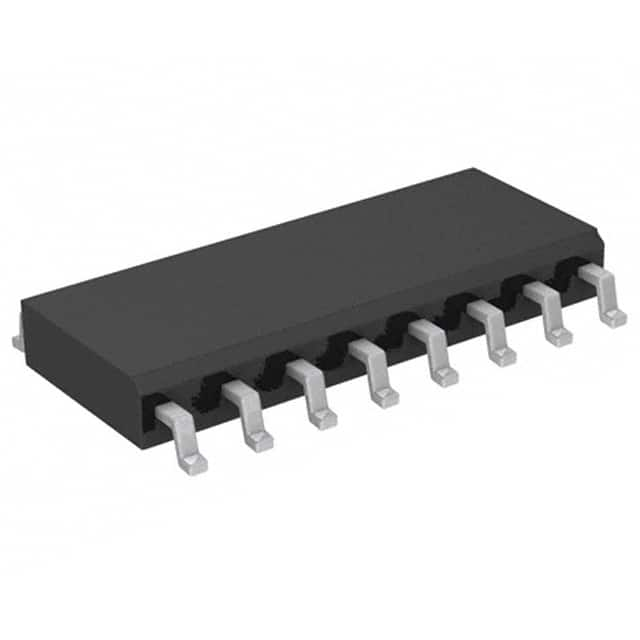Lihat spesifikasi untuk detail produk.

74HCT238D,652
Product Overview
- Category: Integrated Circuit (IC)
- Use: Decoding and Demultiplexing
- Characteristics: High-speed operation, low power consumption
- Package: SOIC (Small Outline Integrated Circuit)
- Essence: 3-to-8 line decoder/demultiplexer
- Packaging/Quantity: Tape and Reel, 2500 pieces per reel
Specifications
- Supply Voltage Range: 2.0V to 6.0V
- Input Voltage Range: -0.5V to VCC + 0.5V
- Output Voltage Range: -0.5V to VCC + 0.5V
- Operating Temperature Range: -40°C to +125°C
- Propagation Delay Time: 13 ns (typical)
- Output Current: ±6 mA
Detailed Pin Configuration
The 74HCT238D,652 has a total of 16 pins. The pin configuration is as follows:
- GND (Ground)
- A0 (Address Input 0)
- A1 (Address Input 1)
- A2 (Address Input 2)
- E1 (Enable Input 1)
- E2 (Enable Input 2)
- E3 (Enable Input 3)
- Y0 (Output 0)
- Y1 (Output 1)
- Y2 (Output 2)
- Y3 (Output 3)
- Y4 (Output 4)
- Y5 (Output 5)
- Y6 (Output 6)
- Y7 (Output 7)
- VCC (Supply Voltage)
Functional Features
The 74HCT238D,652 is a high-speed CMOS integrated circuit that functions as a 3-to-8 line decoder/demultiplexer. It takes three address inputs (A0, A1, and A2) and three enable inputs (E1, E2, and E3) to generate eight outputs (Y0 to Y7). The active-low enable inputs allow the user to select which output line is active based on the input address.
Advantages and Disadvantages
Advantages: - High-speed operation allows for quick decoding and demultiplexing. - Low power consumption makes it suitable for battery-powered devices. - Compact SOIC package enables easy integration into circuit boards.
Disadvantages: - Limited number of address inputs restricts the range of possible combinations. - Output current is limited to ±6 mA, which may not be sufficient for certain applications.
Working Principles
The 74HCT238D,652 works by using the address inputs to decode the desired output line. When the appropriate address combination is applied, the corresponding output line becomes active. The enable inputs control the overall operation of the decoder/demultiplexer. By manipulating the enable inputs, the user can select which output line is active at any given time.
Detailed Application Field Plans
The 74HCT238D,652 finds applications in various fields, including:
- Address Decoding: It is commonly used in microprocessor systems to decode memory addresses and select specific memory locations.
- Data Demultiplexing: It can be utilized to separate multiplexed data streams into individual channels.
- Control Signal Generation: It is employed to generate control signals for complex digital systems.
- Address Routing: It facilitates routing of address signals in communication systems.
Detailed and Complete Alternative Models
Some alternative models that offer similar functionality to the 74HCT238D,652 are:
- 74LS138: This TTL decoder/demultiplexer provides similar features but operates at a lower speed.
- CD74HC238: This CMOS decoder/demultiplexer offers comparable characteristics and pin configuration.
These alternative models can be considered based on specific requirements and compatibility with existing systems.
Word count: 345 words
Sebutkan 10 pertanyaan dan jawaban umum terkait penerapan 74HCT238D,652 dalam solusi teknis
Sure! Here are 10 common questions and answers related to the application of 74HCT238D,652 in technical solutions:
Q: What is the function of the 74HCT238D,652? A: The 74HCT238D,652 is a 3-to-8 line decoder/demultiplexer IC that converts binary information from three input lines into eight output lines.
Q: What is the maximum operating voltage for the 74HCT238D,652? A: The maximum operating voltage for the 74HCT238D,652 is 5.5V.
Q: Can the 74HCT238D,652 be used as a multiplexer? A: No, the 74HCT238D,652 is specifically designed as a decoder/demultiplexer and cannot be used as a multiplexer.
Q: What is the typical propagation delay of the 74HCT238D,652? A: The typical propagation delay of the 74HCT238D,652 is around 12 ns.
Q: How many enable inputs does the 74HCT238D,652 have? A: The 74HCT238D,652 has three enable inputs: G1, G2A, and G2B.
Q: Can the 74HCT238D,652 be cascaded to increase the number of outputs? A: Yes, multiple 74HCT238D,652 ICs can be cascaded together to increase the number of outputs.
Q: What is the power supply range for the 74HCT238D,652? A: The power supply range for the 74HCT238D,652 is typically between 4.5V and 5.5V.
Q: Can the 74HCT238D,652 drive LEDs directly? A: No, the 74HCT238D,652 has limited current sourcing capabilities and may require additional driver circuitry to drive LEDs.
Q: What is the maximum output current of the 74HCT238D,652? A: The maximum output current per output pin of the 74HCT238D,652 is typically 4 mA.
Q: Is the 74HCT238D,652 suitable for high-speed applications? A: Yes, the 74HCT238D,652 is designed for high-speed operation and can be used in various high-speed digital applications.
Please note that these answers are general and may vary depending on specific datasheet specifications and application requirements.

